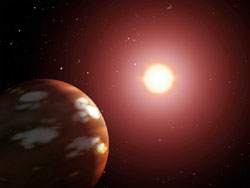Physics and Astronomy
This area deals with the fundamental laws and building blocks of nature and how they interact, the properties and the behavior of matter, and research into space and time and their structures.
innovations-report provides in-depth reports and articles on subjects such as astrophysics, laser technologies, nuclear, quantum, particle and solid-state physics, nanotechnologies, planetary research and findings (Mars, Venus) and developments related to the Hubble Telescope.

The Sun’s X-file under the Spotlight
One of the Sun’s greatest mysteries is about to be unravelled by UK solar astrophysicists hosting a major international workshop at the University of St Andrews from September 6-9th 2004. For years scientists have been baffled by the ’coronal heating problem’: why it is that the light surface of the Sun (and all other solar-like stars) has a temperature of about 6000 degrees Celsius, yet the corona (the crown of light we see around the moon at a total eclipse) is at a temperature of

Royal Astronomical Society September Space Digest
Space digest: September 2004
This release contains a summary of some significant astronomical and space events that will be taking place during September. It has been written in order to assist the media in planning and researching future stories related to space science and astronomy, particularly those with UK involvement. It is not intended to be fully comprehensive. Dates and times may be subject to change.
3 September: ISS Spacewalk
NASA Flight Engineer a

ET, don’t phone home; drop a line instead
Were E.T. really interested in getting in touch with home, he might be better off writing than phoning, according to Christopher Rose, professor of electrical and computer engineering at Rutgers, The State University of New Jersey.
Rose contends that inscribing information and physically sending it to some location in deep space is more energy-efficient than pulsing it out on radio waves, which disperse as they travel.
“Think of a flashlight beam,” Rose says. “Its intensity d

Astronomers Find New Class of Planets Outside The Solar System
Two new “Neptunes” are the smallest extra-solar planets yet—but could be the first of many
A team of astronomers has announced the discovery of some of the smallest planets yet detected beyond our solar system: two worlds that represent a new category of extra-solar planets, as well as significant and much-anticipated advance in the hunt for such objects.
Each of newly discovered planets is roughly comparable to the planet Neptune in our own solar system, says Geoffrey Marcy

Self-assembly generates more versatile scaffolds for crystal growth
Self-organizing synthetic molecules originally used for gene therapy may have applications as templates and scaffolds for the production of inorganic materials. Using electrostatic interactions between oppositely charged molecules as the binding force, scientists are learning how to organize these synthetic molecules into more versatile complexes with large and controllable pore sizes.
“By investigating the fundamental design rules for the control of self-assembled supramolecular str

Equations against hypothermia
Sharks are, by tradition, the eternal threat facing divers. Yet, a diver is quite a lot more unlikely to meet such a creature under the water than, at some time or another, to come up against an even greater danger – hypothermia, or exposure. To enable divers to prevent this syndrome from creeping silently up on them, two researchers from the Area of Applied Physics at the University Jaume I (Spain) have formulated an equation that enables divers to calculate the time they can safely remain submerge